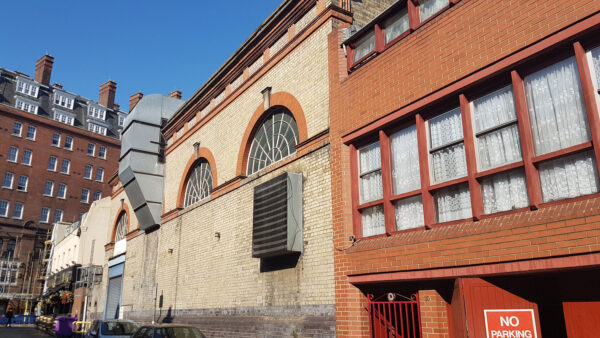Colonnade (sometimes Mews) is a narrow length of pleasing road that’s rather well hidden despite being right next to a central London tube station.
The area was still fields in the late 18th century and the earliest map to show Colonnade is the Wallis’s Plan Of The Cities Of London And Westminster of 1801. By the early 19th, it was entirely built up by the Foundling Hospital, and Colonnade Mews as its known completed. The mews housed stables for the large town houses on Guilford Street and housing for the coachmen.
It seems to have taken its name from the colonnade at the back of the buildings on the north side of Upper Guilford Street. The north side of the mews seems to have been given over to shops, with the southern side reserved for the horses.
In that sense, the mews would have been far busier then than it is today. By the 1870s, the mews was described as being a slum, as the demand for horses was less than expected, and the stables often rented out to the poor.
Most of the mews building were condemned as unfit in 1884, so most of the older buildings date from rebuilding works after that time.
In Colonnade today, the existing ground floor features large timber doors where horses would have been stabled with a much smaller first floor featuring timber sliding sash windows. To the front the original cobbled street surfacing survives.
In the past the buildings on the south side were directly connected to Guilford Street however that connection has been broken for some time when the properties lost the residential use. For some years they were used as storage by Great Ormond Street Hospital, but were refurbished a few years ago to be rented out.
Likewise, the modern row of flats on the opposite side also belong to the hospital, and are rented out to staff who could never otherwise afford to live so close to their place of work.
One modern arrival is the London Underground, in the guise of Russell Square tube station. The huge ventilation and emergency access dominating the modern brick building that slots into the mews.
On the corner is the Horse Hospital, which was built by James Burton in 1797 as stabling for cab drivers’ sick horses. Today it’s less equine than arty — it’s a arts venue with a focus on counter-cultural histories and sub-cultures.
Here the most change has taken place, as when the hotel was constructed, the end of Colonnade was opened up and turned into a separate road, today’s Herbrand Street.
It’s still a pleasant way to avoid the crowds and tourists if needing to get around this part of London though.











Odd to call it Colonnade when it doesn’t have any columns.
Perhaps it comes from the horse hospital? Colonaid is a good additive given to horses. 🤨
The Foundling Hospital dates from an earlier era.
Handel himself was roped into supporting it whilst residing at Brook Street.
Concerts were held there. A lot of hidden London remains hidden unless you know what you are looking for. Fascinating stuff.
Inside the Horse hospital, you still to this day walk up a steep ramp instead of a staircase, the ramp having horizontal bars set at intervals presumably comfortable to a horse, but quite alien to human dimensions.